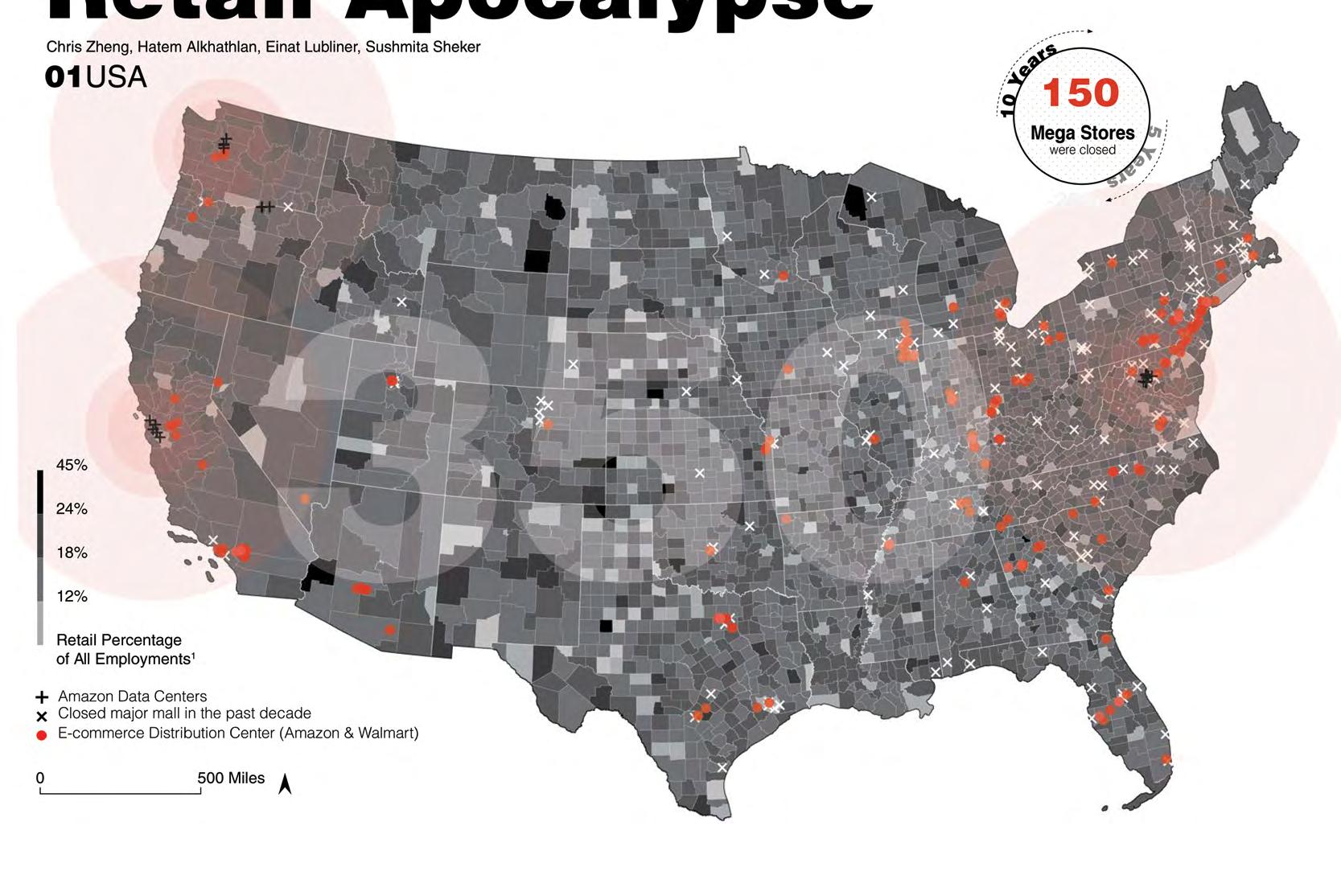
4 minute read
Retail Apocalypse
RETAIL
APOCA
Advertisement
LYPSE
Rethinking the Conventional Model by Einat LUBLINER
Sushmita SHEKAR Hatem ALKHATHLAN Chris ZHENG
Figure 1: In the map above, the red dots represent the e-commerce infrastructure and the white x represents the closed malls.
The global transition from traditional shopping to e-commerce and the change in consumer trends, have led to the transformation of main street retail, Big Box stores and malls which were a de facto social space for American small towns into redundant infrastructure. In the last decade more than 150 malls and big box stores have closed and retail blight is increasing in most cities and suburbs in the US. This identifies with a decline in traditional shopping and the fast growth of the e-commerce industry The e-commerce industry is mostly based on a logistic system, hence through our research we found that it has a greater impact on the carbon footprint. This transition greatly influences consumer behavior. We looked at three types of consumers - the traditional shopper, the online shopper and the impatient shopper (prime user). The prime shoppers who account for 51% of the online shoppers contribute to nearly 3.3kg/e of CO2, owing to the vast amount of freight transportation involved in shipping the orders. The repercussions of this shift has not only increased consumption, but also caused loss of jobs, strengthened monopolies and lack of physical social interaction. The Local economies and small businesses are usually the most vulnerable to this change since they cannot compete with the prices and delivery that the large e-commerce platforms offer. This draws a clear picture of the suburbs of New York- empty retail stores in the main streets, which the rise of the shopping malls created in the 50’s, and vast amounts of ‘dead’ shopping malls and big boxes that the shifting to e-commerce has left behind. As Urban designers we enquire into how the main street had a great impact on the social interaction and social life as in the past. With the shift to shopping malls , the paradigm changedwith greater focus on the product and atmosphere for shopping, and with the advent of e-commerce the social and spatial aspects don’t exist anymore. That led us to question how we can shape a new retail module through a social, economic and

carbon effective lens in the era of the Green New Deal resolution. Our project aims to address the spatial and social aspects of this transition. To investigate this phenomenon further we chose Kingston as a case study to look at this change. Kingston is a city in the lower hudson valley , about 91 miles from New York City. In the last decade the street retail vacancy has increased dramatically and the Hudson Valley mall located at the periphery is on the verge of shutting down. The city has several small businesses and entrepreneurs who have great potential but lack funding and infrastructure. The existing model of these micro businesses is based on the traditional model where each of them depend on individual infrastructure which is less cost effective and increases the carbon footprint. When each individual business has its own supply chain of raw materials, customer shipping, processing machinery, it increases freight transportation, energy consumption and the overall cost of production and sale.
Figure 2: Retail evolution throughout the years and the influence on the public space
We challenged this trajectory by redefining a new retail module that spurs from a bottomup approach through main street revival, by establishing a shared collaborative platform for small businesses. These platforms offer shared space, energy, resources, waste management and storage. This sharing of assets not only reduces cost and carbon emission but also funnels local economy, promotes interaction, elevates jobs, enables social equity. In addition it increases social responsibility and awareness, as consumers now engage with the producers or makers and thereby shifts the focus from consumption to experience. The main street in Kingston has a vast number of vacant storefronts and the streets are predominantly vehicular. Our approach focussed on street activation by broadening the pedestrian path and activating it with collaborative pop up elements. The street social extension has collaborative consumption components for reusing and sharing materials and goods in relation to the Co-op .For example in a textile co-op the remnant fabric can be available for community use. To address this transformation as a holistic sustainable system we re-shape the Big boxes and the malls to form a support infrastructure of the Co-op . The malls and big box stores are repurposed as a local distribution center and

Figure 3: Prototype of the collaborative street model

Figure 4 : Street extension components to support collaborative consumption

Figure 5 : The new
Retail infrastructure implemented in Kingston
recycling center. In order to connect these we reuse the existing rails for transporting raw materials , finished goods and waste to the malls. At this moment in time, as we see the massive shift to the virtual realm, we should rethink how we utilize existing infrastructures rather than acquiring greenfield areas to build new ones over the expanse of an existing ecosystem. The public realm should be also taking into account those transformations as an anchor point for social interaction and equity. Creating micro business through a shared platform of production and marketing, could generate social capital and assets that challenge monopolies and empower local communities. In today’s time financial capital of cities should be measured through social and ecological assets rather than materialism and consumerism.







